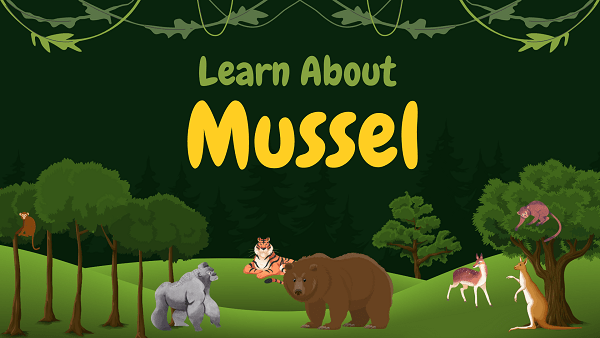Mussel | Facts, Diet, Habitat & Pictures
Home » Animals » Mussel | Facts, Diet, Habitat & Pictures
Mussel Overview
Appearance
A Mussel is a bivalve mollusk with smooth, elongated shells that are typically dark blue-black, brown, or greenish. Their shells are oblong and often bear concentric growth rings. Mussels have a foot-like appendage called a byssus that they use to anchor themselves to surfaces.
They have no visible head but possess two siphons, one for drawing in water and the other for expelling waste. Mussels are known for their ability to form dense colonies in aquatic habitats.
Origins And Evolution
Mussels are bivalve mollusks with smooth, elongated shells that are typically dark blue-black, brown, or greenish. Their shells are oblong and often bear concentric growth rings. Mussels have a foot-like appendage called a byssus that they use to anchor themselves to surfaces.
They have no visible head but possess two siphons, one for drawing in water and the other for expelling waste. Mussels are known for their ability to form dense colonies in aquatic habitats.
Behavior and Lifestyle
Mussels are filter-feeding bivalve mollusks known for their sedentary lifestyle. They anchor themselves to substrates using byssal threads, which they secrete, allowing them to attach firmly to rocks, submerged surfaces, or other mussels.
Mussels feed by drawing in water through one siphon, filtering out tiny plankton and organic particles, and then expelling the filtered water through another siphon. They are known for forming dense colonies in both marine and freshwater habitats, where they provide shelter and food for various aquatic species.
Scientific Classification
- Kingdom: Animalia (Animals)
- Phylum: Mollusca (Mollusks)
- Class: Bivalvia (Bivalves)
- Order: Mytiloida (Mytiloids)
- Family: Mytilidae (Mussels)
Locations
- Coastal regions
- Intertidal zones
- Estuaries
- Rivers
- Lakes
- Ponds
- Streams
- Submerged rocks
- Artificial structures
- Aquaculture facilities
Fast Facts
- Name: Mussel
- Scientific Name: Mytilidae spp.
- Habitat: Aquatic Beds
- Diet: Filter Feeder
- Physical Features: Bivalve Shell
- Nocturnal: Filter-Feeding
- Solitary: Often Clumped
- Unique Order: Bivalvia Mollusks
- Lifespan: 20-30 years
- Conservation Status: Various Threats
- Fun Facts: Water Purifiers
Physical Characteristics
- Color: Variable Hues
- Skin Type: Bivalve Shell
- Top Speed: Stationary Filter
- Lifespan: 20-30 Years
- Weight: Lightweight Shell
- Length: Shell Dimensions
- Age of Sexual Maturity: 2-3 Years
- Age of Weaning: Larval Stage
Mussel FAQs
Are mussels and clams the same thing?
No, mussels and clams are both bivalve mollusks, but they belong to different families and have distinct physical features and habitats.
Are mussels safe to eat?
Yes, mussels are safe to eat when properly cooked. They are a popular seafood delicacy in many cuisines.
Do mussels have pearls like oysters?
Mussels can produce pearls, but they are generally smaller and less valuable than those produced by oysters.
What is the byssus thread in mussels?
The byssus thread is a proteinaceous structure mussels secrete to anchor themselves to surfaces in their environment.
Do mussels move or swim?
Mussels are sessile, meaning they are stationary and do not actively move or swim.
How do mussels reproduce?
Mussels release eggs and sperm into the water, where fertilization takes place. Larvae then develop and settle to become adult mussels.


